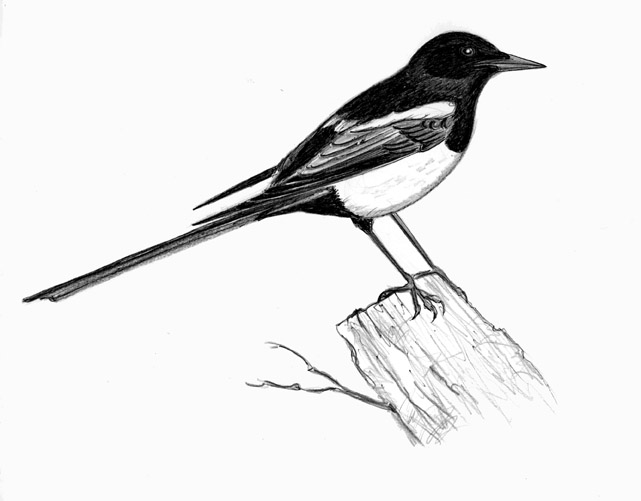
Dear Bird Folks,
I’ve just returned from a cross-country skiing trip in Colorado where I saw several Black-billed Magpies. When I got home I looked through your archives hoping to find more information about these birds, but I only found a column about Australian Magpies. Why did you write about Australia’s magpie and not ours?
– David, Dalton, MA
This is how it works, Dave,
Someone asks me a question and I try to answer it. I don’t think the person who asked me about Australian Magpies (Barbara from Reading, PA, to be exact) would have been happy if my response was, “Sorry Barb, I’m only allowed to write about native birds. Dalton Dave wants me to keep things local. You’ll have to write to the State Department if you want to hear about foreign birds.” And while we are on the topic of keeping things local, did you really need to travel to Colorado to go cross-country skiing? What’s wrong with the local ski trails? Oh, right. No snow this year. I forgot. You’re off the hook this time, Dave.
I know I just gave you a hard time, but I’m glad you wrote. The truth is, I’d much rather write about North American magpies than the Aussie bird. Our magpies (we have two, Black-billed and Yellow-billed) are sleek and beautifully marked, while theirs looks like a blotchy crow that didn’t come out right. Australia has some beautiful birds, but when it comes to magpies, we rule. The first thing most folks notice about the Black-billed Magpie is its tail, which is greenish and ridiculously long. How long? Ten inches. That’s long for a songbird. In addition to the tail, the bird has blue-green, iridescent wings and a bold black & white body. This bird is totally distinctive and eye-catching. You aren’t likely to mix it up with another bird and certainly not one from Australia. As I mentioned, the magpie is listed as a songbird, but its song is unquestionably an acquired taste. The song, if we can call it that, is a series of harsh notes…definitely not something anyone is likely to buy on iTunes, even on sale.
The Black-billed Magpies’ range is pretty much restricted to the western portion of North America. So if you are driving across the country you don’t need to start looking for one until you reach Wichita, Kansas. When you get to Wichita, and before you start looking for birds, stop and order a pizza. The first Pizza Hut was started in Wichita in 1958. I know that doesn’t have much to do with what we are talking about, but I thought I’d interject a little “slice” of Americana. After all, when we think of good pizza, the first place that comes to mind is Wichita, KS. Magpies are closely related to crows and like most members of the crow family magpies aren’t fussy eaters. Their diet includes grain, grasshoppers, carrion and pizza crust. The have also been known to land on the backs of large mammals (deer and buffalo) and feed on ticks. When the birds have had their fill, they will take the extra ticks and cache them for later use. However, unlike other cached food (carrion and crust), the ticks aren’t always dead when they are cached. After the birds leave the ticks get up, shake their heads and walk away, wondering, “What was that all about?”
When resting or watching for danger magpies tend to sit in tall trees, but when feeding they are strictly terrestrial. They search for insects by confidently strutting along the ground, walking with a distinctive gait, looking like feathered gunfighters or tiny John Waynes. The omnivorous magpies also eat young birds, including the chicks of domestic chickens. This habit made them enemies of farmers and ranchers, who did their best to wipe them out. Fortunately, those efforts had little effect on the birds’ population. And despite the farmers’ ugliness, magpies actually seem to like people. They are very inquisitive birds and if not harassed will allow close approach. Lewis and Clark, in their famous journal, noted that one day several magpies flew into the explorers’ tent and helped themselves to some supplies. It’s also rumored that later that night the birds came back and challenged Lewis to a game of Black jack. They cleaned him out. Clark wisely stayed out of the game.
When nesting season rolls around magpies build rather large, bulky nests. Magpies are energetic birds, but appear to have a touch of ADD since they can’t seem to focus on the task at hand. It usually takes well over a month for a couple to finish their nest. Using stereotypical roles from the ‘50s, the male does all of the heavy work. He puts up the sticks and branches for the frame, while the more artistic female does all the finish work inside. Even though the process is slow, the results are impressive. A magpie nest not only has a floor and sides, but it also has a roof. Under this roof the baby ‘pies are well protected from weather and passing avian predators. These nests are so well constructed they typically last for years and are frequently reused by other critters including owls, kestrels and hipsters from Aspen who think they’ve found a fashionable new place to live.
In spite of my earlier teasing, Dave, I’m glad you asked about the magpies. They are one of the many reasons to make a trip out West. The western half of the country is unsurpassed in its beauty, fresh air and wildlife. The West has it all, except maybe good pizza.